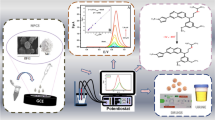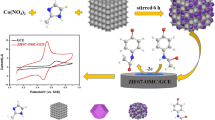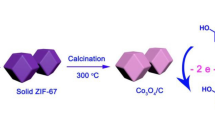Abstract
The one-step synthesis of heteroatom-doped porous carbons is reported with the in situ formation of cobalt oxide nanoparticles for dual electrochemical applications (i.e., electrochemical sensor and supercapacitor). A single molecular template of zeolitic imidazole framework-67 (ZIF-67) was utilized for the solid-state synthesis of cobalt oxide nanoparticle–decorated nitrogen-doped porous carbon (Co3O4@NPC) nanocomposite through a facile calcination treatment. For the first time, Co3O4@NPC nanocomposite derived from ZIF-67 has been applied as an electrode material for the efficient electrochemical detection of anticancer drug flutamide (FLU). The cyclic voltammetry studies were performed in the operating potential from 0.15 to − 0.65 V (vs. Ag/AgCl). Interestingly, the fabricated drug sensor exhibited a very low reduction potential (− 0.42 V) compared to other reported sensors. The fabricated sensor exhibited good analytical performance in terms of low detection limit (12 nM), wide linear range (0.5 to 400 μM), and appreciable recovery results (~ 98%, RSD 1.7% (n = 3)) in a human urine sample. Hereafter, we also examined the supercapacitor performance of the Co3O4@NPC-modified Ni foam in a 1M KOH electrolyte, and noticeable a specific capacitance of 525 F g−1 at 1.5 A g−1 was attained, with long-term cycling stability. The Co3O4@NPC nanocomposite supercapacitor experiments outperform the associated MOF-derived carbons and the Co3O4-based nanostructure-modified electrodes.
Graphical abstract









Similar content being viewed by others
References
Kadivar M, Aliakbar A (2021) A molecularly imprinted poly 2-aminophenol-gold nanoparticle-reduced graphene oxide composite for electrochemical determination of flutamide in environmental and biological samples. Anal Methods 13:536–551. https://doi.org/10.1039/d0ay01812k
Kesavan G, Chen SM (2021) Highly sensitive manganese oxide/hexagonal boron nitride nanocomposite: an efficient electrocatalyst for the detection of anti-cancer drug flutamide. Microchem J 163:105906. https://doi.org/10.1016/j.microc.2020.105906
Rezaeifar Z, Rounaghi GH, Es’haghi Z, Chamsaz M (2018) Electrochemical determination of anticancer drug, flutamide in human plasma sample using a microfabricated sensor based on hyperbranchedpolyglycerol modified graphene oxide reinforced hollow fiber-pencil graphite electrode. Mater Sci Eng C 91:10–18. https://doi.org/10.1016/j.msec.2018.05.017
Hu X, Shi W, Wei S et al (2013) Occurrence and potential causes of androgenic activities in source and drinking water in China. Environ Sci Technol 47:10591–10600. https://doi.org/10.1021/es401464p
He H, Morely JE, Silva-Lopez E et al (2009) Synthesis and characterization of nonsteroidal-linked M(CO) 3+(M = 99mTc, Re) compounds based on the androgen receptor targeting molecule flutamide. Bioconjug Chem 20:78–86. https://doi.org/10.1021/bc8003183
Suresh PS, Srinivas NR, Mullangi R (2018) Review of HPLC and LC-MS/MS assays for the determination of various nonsteroidal anti-androgens used in the treatment of prostate cancer. Biomed Chromatogr 32:e4034. https://doi.org/10.1002/bmc.4034
Khan N, Abdelhamid HN, Yan JY et al (2015) Detection of flutamide in pharmaceutical dosage using higher electrospray ionization mass spectrometry (ESI-MS) tandem mass coupled with Soxhlet apparatus. Anal Chem Res 3:89–97. https://doi.org/10.1016/j.ancr.2015.01.001
Nagaraja P, Sunitha KR, Silwadi MF (2000) New spectrophotometric method for the determination of flutamide in pharmaceutical preparations. J Pharm Biomed Anal 23:617–622. https://doi.org/10.1016/S0731-7085(00)00319-8
Asif M, Liu H, Aziz A et al (2017) Core-shell iron oxide-layered double hydroxide: high electrochemical sensing performance of H2O2 biomarker in live cancer cells with plasma therapeutics. Biosens Bioelectron 97:352–359. https://doi.org/10.1016/j.bios.2017.05.057
Ashraf G, Asif M, Aziz A et al (2021) Rice-spikelet-like copper oxide decorated with platinum stranded in the CNT network for electrochemical in vitro detection of serotonin. ACS Appl Mater Interfaces 13:6023–6033. https://doi.org/10.1021/acsami.0c20645
Ramadhass KD, Ganesan M, Chen T-W et al (2021) 3D honey-comb like nitrogen self-doped porous carbon networks for high-performance electrochemical detection of antibiotic drug furazolidone. J Electrochem Soc 168:047503. https://doi.org/10.1149/1945-7111/abf21d
Muthusankar G, Sethupathi M, Chen SM et al (2019) N-doped carbon quantum dots @ hexagonal porous copper oxide decorated multiwall carbon nanotubes: a hybrid composite material for an efficient ultra-sensitive determination of caffeic acid. Compos Part B Eng 174:106973. https://doi.org/10.1016/j.compositesb.2019.106973
Muthusankar G, Sangili A, Chen SM et al (2018) In situ assembly of sulfur-doped carbon quantum dots surrounded iron(III) oxide nanocomposite; a novel electrocatalyst for highly sensitive detection of antipsychotic drug olanzapine. J Mol Liq 268:471–480. https://doi.org/10.1016/j.molliq.2018.07.059
Meng F, Fang Z, Li Z et al (2013) Porous Co3O4 materials prepared by solid-state thermolysis of a novel co-MOF crystal and their superior energy storage performances for supercapacitors. J Mater Chem A 1:7235–7241. https://doi.org/10.1039/c3ta11054k
Guo Y, Tang J, Salunkhe RR et al (2017) Effect of various carbonization temperatures on ZIF-67 derived Nanoporous carbons. Bull Chem Soc Jpn 90:939–942. https://doi.org/10.1246/bcsj.20170138
Saraf M, Rajak R, Mobin SM (2019) MOF derived high surface area enabled porous co 3 O 4 nanoparticles for supercapacitors. ChemistrySelect 4:8142–8149. https://doi.org/10.1002/slct.201901652
Wang Q, Astruc D (2020) State of the art and prospects in metal-organic framework (MOF)-based and MOF-derived nanocatalysis. Chem Rev 120:1438–1511
Wang H, Shao Y, Mei S et al (2020) Polymer-derived heteroatom-doped porous carbon materials. Chem Rev 120:9363–9419
Tahir MU, Arshad H, Xie W et al (2020) Synthesis of morphology controlled NiCo-LDH microflowers derived from ZIF-67 using binary additives and their excellent asymmetric supercapacitor properties. Appl Surf Sci 529:147073. https://doi.org/10.1016/j.apsusc.2020.147073
Lü Y, Zhan W, He Y et al (2014) MOF-templated synthesis of porous Co3O4 concave nanocubes with high specific surface area and their gas sensing properties. ACS Appl Mater Interfaces 6:4186–4195. https://doi.org/10.1021/am405858v
Torad NL, Salunkhe RR, Li Y et al (2014) Electric double-layer capacitors based on highly graphitized nanoporous carbons derived from ZIF-67. Chem - A Eur J 20:7895–7900. https://doi.org/10.1002/chem.201400089
Torad NL, Kim J, Kim M et al (2020) Nanoarchitectured Porous Carbons Derived from ZIFs toward Highly Sensitive and Selective QCM Sensor for Hazardous Aromatic Vapors. J Hazard Mater 405:124248. https://doi.org/10.1016/j.jhazmat.2020.124248
Zhou K, Mousavi B, Luo Z et al (2017) Characterization and properties of Zn/Co zeolitic imidazolate frameworks vs. ZIF-8 and ZIF-67. J Mater Chem A 5:952–957. https://doi.org/10.1039/C6TA07860E
Sheng P, Wang G, Dong M et al (2017) Systematic study of the crystallization process of CrAPO-5 using: in situ high resolution X-ray diffraction. RSC Adv 7:22964–22973. https://doi.org/10.1039/c6ra28572d
Zhang L, Zhao X, Ma W et al (2013) Novel three-dimensional Co3O4 dendritic superstructures: hydrothermal synthesis, formation mechanism and magnetic properties. CrystEngComm 15:1389–1396. https://doi.org/10.1039/c2ce26374b
Ferrari AC, Basko DM (2013) Raman spectroscopy as a versatile tool for studying the properties of graphene. Nat Nanotechnol 8:235–246. https://doi.org/10.1038/nnano.2013.46
Wang J, Tu J, Lei H, Zhu H (2019) The effect of graphitization degree of carbonaceous material on the electrochemical performance for aluminum-ion batteries. RSC Adv 9:38990–38997. https://doi.org/10.1039/C9RA07234A
Wei T, Zhang Q, Wei X et al (2016) A facile and low-cost route to heteroatom doped porous carbon derived from Broussonetia Papyrifera bark with excellent supercapacitance and CO2 capture performance. Sci Rep 6:1–9. https://doi.org/10.1038/srep22646
Madhu R, Veeramani V, Chen S-M et al (2015) Honeycomb-like porous carbon–cobalt oxide nanocomposite for high-performance enzymeless glucose sensor and supercapacitor applications. ACS Appl Mater Interfaces 7:15812–15820. https://doi.org/10.1021/acsami.5b04132
Ensafi AA, Talkhooncheh BM, Zandi-Atashbar N, Rezaei B (2020) Electrochemical sensing of flutamide contained in plasma and urine matrices using NiFe 2 O 4 /rGO nanocomposite, as an efficient and selective electrocatalyst. Electroanalysis 32:1717–1724. https://doi.org/10.1002/elan.202000048
Kubendhiran S, Sakthivel R, Chen S-M et al (2018) Innovative strategy based on a novel carbon-black−β-cyclodextrin nanocomposite for the simultaneous determination of the anticancer drug flutamide and the environmental pollutant 4-Nitrophenol. Anal Chem 90:6283–6291. https://doi.org/10.1021/acs.analchem.8b00989
Suvina V, Kokulnathan T, Wang T-J, Balakrishna RG (2020) Unraveling the electrochemical properties of lanthanum cobaltite decorated halloysite nanotube nanocomposite: an advanced electrocatalyst for determination of flutamide in environmental samples. Ecotoxicol Environ Saf 190:110098. https://doi.org/10.1016/j.ecoenv.2019.110098
Wang K, Yi X, Luo X et al (2016) Fabrication of Co3O4 pseudocapacitor electrodes from nanoscale cobalt–organic frameworks. Polyhedron 109:26–32. https://doi.org/10.1016/j.poly.2016.01.046
Luan VH, Han JH, Kang HW, Lee W (2019) Highly porous and capacitive copper oxide nanowire/graphene hybrid carbon nanostructure for high-performance supercapacitor electrodes. Compos Part B Eng 178:107464. https://doi.org/10.1016/j.compositesb.2019.107464
Xu C, Chen Y, Ma Y, et al (2020) Waste activated carbon transformed to electrode of supercapacitor through combining with Co(OH)2. Electrochim Acta 137475. https://doi.org/10.1016/j.electacta.2020.137475
Hekmat F, Shahrokhian S, Hosseini H (2019) Direct growth of nickel-cobalt oxide nanosheet arrays on carbon nanotubes integrated with binder-free hydrothermal carbons for fabrication of high performance asymmetric supercapacitors. Compos Part B Eng 172:41–53. https://doi.org/10.1016/j.compositesb.2019.05.027
Funding
The Ministry of Science and Technology, Taiwan, has financially supported this work through contract no. MOST 107-2113-M-027-005-MY3.
Author information
Authors and Affiliations
Corresponding author
Ethics declarations
Conflict of interest
The authors declare that they have no competing interests.
Additional information
Publisher’s note
Springer Nature remains neutral with regard to jurisdictional claims in published maps and institutional affiliations.
Supplementary Information
ESM 1
(DOCX 3924 kb)
Rights and permissions
About this article
Cite this article
Devi, R.K., Muthusankar, G., Chen, SM. et al. In situ formation of Co3O4 nanoparticles embedded N-doped porous carbon nanocomposite: a robust material for electrocatalytic detection of anticancer drug flutamide and supercapacitor application. Microchim Acta 188, 196 (2021). https://doi.org/10.1007/s00604-021-04860-8
Received:
Accepted:
Published:
DOI: https://doi.org/10.1007/s00604-021-04860-8




